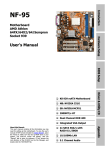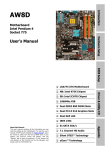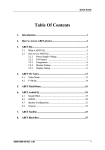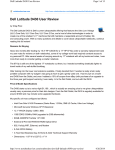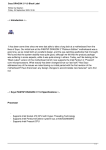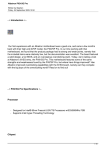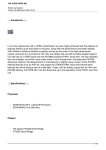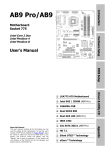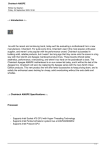Download Abit AMD Athlon 64 System Board Socket 754 Specifications
Transcript
abit KV8-MAX3 Written by Chris Emry Friday, 04 September 2009 10:39 ..:: Introduction ::.. It has been nearly three months since the initial release of AMD's Athlon 64 microprocessors. Within that time frame, many hardware websites have been publishing reviews claiming that the ABIT KV8-MAX3 is one of the best motherboards you can drop a 754-pin processor into. So, why would we even begin to think about publishing a review about the exact same motherboard that has been reviewed nearly ten times over and has already received high praises and awards? Well, we've read these reviews about this particular board like yourself, because after all we are enthusiasts too, but what has ABIT ultimately been able to prove to MBReview with this release? Did these websites overlook anything that was crucial for you, the consumer, to know about? Will the KV8-MAX3 show us a fun-filled maximum experience like others have claimed or become a maximum letdown? Believe me, you don't want to skip to the conclusion for this one! Let's get started by taking a look at the specifications below. ..:: ABIT KV8-MAX3 Specifications ::.. Processor - Socket-754 for AMD Athlon 64 1 / 19 abit KV8-MAX3 Written by Chris Emry Friday, 04 September 2009 10:39 Chipset - VIA K8T800 Northbridge VIA VT8237 Southbridge 3Com Gigabit LAN Realtek ALC658 Audio Silicon Image Sil3114 RAID Memory - 3 x 72-bit Single Channel DDR up to 2GB - Supports 3 DIMM DDR333 - Supports 2 DIMM DDR400 Expansion Slots - 1 x AGP 8X 5 x PCI 2 x UDMA/133/100/66 1 x FDD 6 x SATA IDE/RAID 8 x USB 2.0 3 x FireWire 2 / 19 abit KV8-MAX3 Written by Chris Emry Friday, 04 September 2009 10:39 Back Panel I/O Ports - 1 x Parallel, 1 x Serial 1 x PS/2 Keyboard, 1 x PS/2 Mouse 5 x Audio I/O 4 x USB 2.0, 1 x RJ-45 Port 1 x S/PDIF In, 1 x S/PDIF Out 1 x IEEE1394 1 x OTES Exhaust Fan Special Features - Abit SoftMenu III - Abit OTES - Abit uGuru BIOS Features - Phoenix-Award BIOS 3 / 19 abit KV8-MAX3 Written by Chris Emry Friday, 04 September 2009 10:39 - 4MB Flash ROM Form Factor - ATX Form Factor (12 in. x 9.64 in.) ..:: ABIT KV8-MAX3 Product Package ::.. The box that the KV8-MAX3 ships in is a nice change from the typical ABIT box with the F1 race car on the front. The KV8-MAX3 can be easily distinguished from other motherboards considering that the shipping box has a large KV8-MAX3 logo stamped all over it along with the AMD Athlon64, OTES and µGuru logos on top. There is also an artist's rendition of what the KV8-MAX3 could look like, but it's too bad the actual board doesn't look that way. More on that later. 4 / 19 abit KV8-MAX3 Written by Chris Emry Friday, 04 September 2009 10:39 One aspect ABIT is well known for in the enthusiast community is their capability to provide the customer with comprehensive and detailed documentation for their motherboards, and you can bet that the KV8-MAX3 follows in this tradition. ABIT tosses in a detailed user manual, a quick installation guide, another guide for their µGuru feature, and a sticker to affix to the interior of the computer case for quick references to the motherboard layout. The sticker will come in handy if you often find yourself poking around your motherboard, or happen to lose manuals as much as I seem to. The bundled accessories include the usual software and driver discs, an expansion bracket with two IEEE1394 ports and two USB ports attached, four SATA cables, three various Molex splitters for power support of SATA devices, one round UDMA/133 cable, one round floppy cable, and of course the appropriate I/O bracket. Unfortunately, the KV8-MAX3 does not come with the heatsink mounting cage which is required to mount a cooling unit to the AMD Athlon64 processor properly, so make sure you have one in your cart before you race to the checkout counter. Abit also includes a package called Secure IDE with the KV8-MAX3. As the name of this device implies, it will encrypt data on an UDMA hard drive for increased file protection. While this is a nice addition to the bundle, we would rather see Abit include at least one of their Serillel adapters instead so that we can use a UDMA hard drive and connect it to an integrated SATA connector the KV8-MAX3 provides. Two of them would be even better so that we could use them in a RAID array. One feature that has not been shown in the images above is that all of these bundled accessories are placed neatly in boxes within the KV8-MAX3's main shipping box. I really wish all manufactures would start to do this as ABIT has. By doing this, the manufacturer can further ensure that there is far less of a chance the accessories will acquire any minor damage, or even worse... significant damage to the motherboard surface, or the various mounted components the after it has traveled around the globe, finally arriving at your doorstep. 5 / 19 abit KV8-MAX3 Written by Chris Emry Friday, 04 September 2009 10:39 ..:: ABIT KV8-MAX3 Software Suite ::.. After the KV8-MAX3 has a fresh OS installed, the next thing you will need to do is install the drivers for the chipset and any integrated components you have decided to utilize. Simply insert the disc into your CD drive, and a window will proceed to pop up and display the correct drivers for each of the vital components, along with those of the optional hardware that you chose to enable via the BIOS. Click on the driver/s that you want to install, and a wizard will lead the way. It couldn't be any simpler. The only way you will be able to fully interact with the heart and soul of ABIT’s exclusive µGuru feature is with a software package run from a Windows environment, so let's go over this feature now. The µGuru software that was shipped to us with our KV8-MAX3 sample is the 1.12 version. There are a total of six different categories within the µGuru feature, and they are as follows: OCGuru, ABITEQ, FanEQ, AudioEQ, FlashMenu and BlackBox. OCGuru is a utility that was designed to help novices and experts alike with overclocking system components in real time. This allows for the user to avoid the hassle of constant restarts after nudging the frequencies up a bit to check for system stability, and then repeating the process until they have achieved a maximum stable overclock. Unfortunately, our experience with OCGuru proved to be rather fruitless. When we attempted to work with the OCGuru featured, no matter the frequency we tried to set the FSB to, it would always spike the FSB frequency an extra 20MHz, resulting in a system failure. It will be interesting to see how OCGuru will develop as the K8 platform matures, or how it works on current mature platforms, such as the AMD AthlonXP or the Intel Pentium 4, as ABIT releases these motherboards with their µGuru chip. 6 / 19 abit KV8-MAX3 Written by Chris Emry Friday, 04 September 2009 10:39 ABITEQ is a program that will monitor all voltages and component temperatures within your PC. This software seemed to work without error, and it has many options and available settings so that you can configure each individual value to a specific value that works best for you. If you are familiar with using other hardware monitoring programs, such as the various incarnations of the famed Motherboard Monitor software, then ABITEQ can only aid you with increased precision since the program was customized specifically for your KV8-MAX3. The FanEQ software is, for all intents and purposes, the exact same thing that you will find in the BIOS for this µGuru feature, although it increases the ease of use as it can be used with a software interface. As the name of FanEQ suggests, the program will automatically adjust fan speeds in real time according to temperatures for the CPU, Northbridge and OTES fans. If you are on the hunt for a virtually noiseless system, then FanEQ will be a welcomed and useful addition to your setup. AudioEQ is probably the least exciting category within the µGuru feature. It is basically a software suite that will only work if you decide to use the integrated audio on the KV8-MAX3. Over the last two years, we have seen integrated audio solutions really begin to step up to the plate as far as sound quality, and capabilities go. Nevertheless, most audio enthusiasts will still choose to opt with a PCI solution that will offer superior recording and playback quality, along with a lessened burden on the CPU. The AudioEQ software itself is an interface that will allow the user to adjust the equalizer themselves or pick from a list of presets. ABIT FlashMenu is wonderful and worked with absolute perfection. Although this idea is nothing new, as we have used a feature like this from other manufacturers, no longer will a user have to search around ABIT’S website for the correct BIOS file, download the file, boot from a floppy disc and insert command switches to flash the BIOS. All the user will have to do now is click the button where it says "One Click Live Update," sit back, and relax while FlashMenu updates your BIOS to the latest available version. 7 / 19 abit KV8-MAX3 Written by Chris Emry Friday, 04 September 2009 10:39 BlackBox is an interesting and most welcome idea. ABIT claims that BlackBox will be able to record system crashes or failures, and then be able to report these errors to ABIT technical support for diagnostic purposes. Unfortunately, BlackBox will not be able to help the end user with each and every error a user could face, but this is the best thing I have ever seen implemented on a motherboard from a manufacturer that is willing to improve the technical support area of their products. In the long run, BlackBox will help out both parties tremendously as this technology develops. ..:: ABIT KV8-MAX3 Layout ::.. The KV8-MAX3 is the latest addition to ABIT’s famed MAX motherboard lineup, but there is still one category that they continue to fall short in with almost every release, and it has to do with the appearance of the board. Sure, cosmetics are probably one of the last aspects that any manufacturer concentrates on unless the board is targeted towards the modding community, but the actual look of the product can only compliment a package that is being promoted as the best in computer hardware. Using an enhanced color theme (like the one pictured on the shipping box) could possibly make the consumer have a second look, which can only be a good thing. The upper portion of the ABIT KV8-MAX3 around the processor socket and Northbridge is very crowded, and I honestly cannot find anything in this part of the motherboard's design that I consider desirable. First of all, the processor socket is too close to the OTES (Outside Thermal 8 / 19 abit KV8-MAX3 Written by Chris Emry Friday, 04 September 2009 10:39 Exhaust System) mechanism. So close in fact that installing or removing a heatsink would always scratch or bend the OTES. Luckily, ABIT has addressed this problem, and only the first 200 units that shipped out of manufacturing were plagued by this problem. If you were to purchase a retail motherboard today, you would receive a board with the modified OTES design that takes care of the heatsink mounting issues. Another problem is that both of ATX power connectors have been sandwiched in-between some capacitors and the I/O back panel, which could make it extremely difficult to tidy up cables, and could also give the user a hard time removing or installing each power connector because of their current locations. Finally, while other hardware review sites have reported that the Northbridge heatsink and fan was rather quiet on their KV8-MAX3 sample, I beg to differ. Maybe the fan on our sample is an exception, but it always produced an annoying whine that could be heard over all of the other fans within the test system at the highest RPM setting. We have talked this issue over with ABIT, and it seems that this is indeed a problem that is likely limited to our testing sample as this isn’t a widespread problem. I was pleased, however, to find that ABIT coated the K8T800 Northbridge with some thermal grease to help aid in thermal transfer to pull heat away from the chip more efficiently than using a standard thermal adhesive pad. It was also rather easy to remove the heatsink and fan unit, should you decide to replace it with a more elaborate or passive cooling solution. When we flip the KV8-MAX3 over, we can see that the OTES cooling system is held to the motherboard using two screws and a plastic nut for each screw. This mounting hardware is run through two of the motherboard mounting holes. You might want to remove each nut before you install the KV8-MAX3 in your case, because the motherboard could bend slightly and not line up correctly with the I/O bracket. This could also possibly be the reason why some users, including ourselves, have been greeted with a siren sound when turning on the KV8-MAX3 for the first time. After we removed the nuts and then reinstalled the board in our case, the KV8-MAX3 worked flawlessly throughout operation. If nothing else, we hope that knowing about what we did to get past the siren sound can give the user another chance to get the motherboard up and running before requesting an RMA number. 9 / 19 abit KV8-MAX3 Written by Chris Emry Friday, 04 September 2009 10:39 Within the expansion slot area, there are two red colored FireWire headers that have been placed in-between the AGP slot and the first PCI slot. We think another location for these headers would be more appropriate, so the required cables won't block airflow or get entangled with the fan on your video card. Additionally, if you are using a video card that has one of those massive GPU cooling solutions, you might not be able to use the FireWire headers at all. The large rectangular chip that resides to the very left of the FireWire headers is the 3Com Gigabit Ethernet Controller which provides up to a 1000Mbps connection for networking. The small Realtek ALC658 audio chip is located to the left of the fourth and fifth PCI slots, and the accompanying onboard audio connectors and header resides just above it. I would like to mention, however, that the integrated audio on the KV8-MAX3 is the best onboard solution that I have ever heard. Whether it was the legendary sound of Bob Marley or the harder sound of Tool, the music that this integrated audio solution provided was simply put, crystal clear, only coming in a close second to my Fortissimo III add-on sound card. ..:: ABIT KV8-MAX3 Layout Cont. ::.. Although we could not get a clear enough picture to show to you, we were unable to use some of our PCI cards in the fourth PCI slot. With almost every PCI card we tried to install, the screw that holds the bracket to the PCI device would always come in contact with the CD audio in header, totally preventing the installation of a PCI card in this particular slot. This design isn't the worst interference that we have seen before on a motherboard, but any type of interference that could possibly prevent the installation of a device is unacceptable. This area also houses a single, red, three-pin fan header under the last PCI slot, but I would have preferred to see this located near the front panel header instead. The Southbridge area on the KV8-MAX3 is littered with various chips and connectors, so let us begin to work our way around this area of the motherboard by mentioning that the white colored front panel header rests in the bottom right corner. To the left of the front panel header are four SATA/150 connectors that will be used in conjunction with the Silicon Image Sil3114 SATA RAID chip. This chip can provide a RAID 0, 1, or 0+1 array for the latest interface in hard drive technology. Just above this chip, and to the right of the second and third PCI slots are two blue USB 2.0 headers which will allow you to connect four additional USB 2.0 ports to your computer. 10 / 19 abit KV8-MAX3 Written by Chris Emry Friday, 04 September 2009 10:39 To the immediate right of the USB 2.0 headers is the VIA VT8237 Southbridge. The two SATA ports that the Southbridge natively supports rest to the right of the VT8237, with a yellow colored Clear_CMOS jumper just beneath them. Although the Clear_CMOS jumper cap has an extended tip, the location of the Clear_CMOS jumper could be hard to grab hold of if you have the SATA cables attached to these two connectors. Above the front panel header is the floppy connector. It would have been much better if ABIT decided to place the floppy connector lying parallel to the right edge of the board so that you could route a floppy cable easier within the case. The floppy connector could also block the visualization of codes from the diagnostic LED that has been placed right above it, but we are glad to see that the diagnostic LED is onboard and wish every motherboard could be equipped with this helpful luxury. To the left of the diagnostic LED is ABIT’s exclusive µGuru chip, while the System BIOS chip is located on the other side of the LED display between the floppy connector and the Winbond hardware monitoring chip. As we make our way into the memory portion of the PCB, we next see two IDE connectors are located farther up the right edge of the KV8-MAX3. The location of these IDE connectors is in an ideal position, allowing improved air circulation inside the case when bulky IDE cables are attached. The system buzzer and an additional fan header are in this area as well, located under the IDE connectors beside a motherboard mounting hole. The CPU fan header cannot be seen in the image above, but it rests in-between the first DIMM slot and where the edge of the OTES mechanism begins to pull air through this enhanced cooling solution. Now, another problem with the design is evident within the memory area. No matter how many times we stress to motherboard manufacturers concerning problematic areas with their designs, an installed video card in the AGP slot will repeatedly interfere with removing or installing extra memory in the memory slots if each of these slots are placed too close to one another. This design flaw can be found on many motherboards, much more than we would like to admit, and unfortunately this problem is present on the KV8-MAX3. This makes it overly difficult to perform a memory upgrade which should be the easiest type of upgrade for any computer system. In many cases, this problem is merely due to lack of available real-estate on the motherboard, and from the optimal trace routing that the simulators gave to the engineers, although we still don’t care for this common problem, to say the least. 11 / 19 abit KV8-MAX3 Written by Chris Emry Friday, 04 September 2009 10:39 Our last stop on the KV8-MAX3’s PCB is the rear I/O panel, and as you can see, the design is very different from what can be found on the majority of boards on the market. The panel consists of the OTES exhaust fan at the top, two PS/2 ports, two S/PDIF ports to be used with the other five audio ports, one FireWire port, one RJ-45 LAN port, and finally four USB 2.0 ports. ..:: ABIT KV8-MAX3 System BIOS ::.. The KV8-MAX3 is equipped with ABIT’s popular SoftMenu III customized Phoenix-Award BIOS. The images shown below are with the 1.6 version (updated using uGuru FlashMenu) and this release was also used for all of our benchmarking, overclocking and torture tests. The images below represent what the KV8-MAX3 can offer over a typical enthusiast BIOS. All of the overclocking options for the KV8-MAX3 are located within the SoftMenu III section of the BIOS, and the image above was taken with the highest settings available for each individual overclocking option. I seriously doubt that anyone could possibly need more for their overclocking adventures since the AGP and PCI clocks cannot be locked, and also taking the infancy of the K8 core into account. The VCore selections can be adjusted in a rather unusual way, to provide voltage to the processor in .01v increments. Focus your attention now to the phrase at the very bottom of the SoftMenu III screen. It reads "Press F8 to OC on the Fly" and we tried several times with numerous configurations, but pressing the F8 key did absolutely nothing. 12 / 19 abit KV8-MAX3 Written by Chris Emry Friday, 04 September 2009 10:39 The image above represents what the ABIT KV8-MAX3 can offer a user for tweaking their installed memory of choice. These options are available in the DRAM configuration sub-menu found within the Advanced Chipset Features main menu. The actual memory timing settings for each one listed has a very broad range, so if you are planning on squeezing out a CAS 2.0-2-2-2-5-1T timing set, or to aim for a high FSB with CAS 3-etc., you need not worry. The KV8-MAX3 has got you covered. You just have to make sure your memory can handle what you throw at it, and then you are off to tweak the night away. The last section of the BIOS we are going to take a look at is called FanEQ. This is a section of the BIOS that will work in conjunction with the ABIT µGuru chip. It will surely come in handy for some users, especially if you have a fan that made the annoying sound that we experienced in our tests when it was spinning at the highest RPM setting. Just set the values to whatever suits your fancy and the µGuru chip will adjust the speed of the fan based on the temperature range of the selected device. ..:: ABIT KV8-MAX3 Overclocking ::.. With the given amount of headroom and options within the BIOS of the KV8-MAX3, we were curious to see how well the board could overclock our test system. Our overclocking adventures, of course, had to be performed manually since the OCGuru software failed to prove it could do it for us. I wasn't too surprised to see that ABIT’s solution was able to push the system farther than any other K8T800 chipset based motherboard we have tested to date, since the engineers at ABIT are the pioneers of overclocking. The motherboard finally hit a 440MHz DDR FSB ceiling while the memory timings remained at 2.0-3-3-6-1T. I did have to increase the processor voltage to 1.6v, the Hyper-Transport voltage to 1.35v, and the DDR voltage to 2.8v to get our maximum result, but the KV8-MAX3 proved to us that it could still complete our tests without fault at these settings. Anything higher and the 13 / 19 abit KV8-MAX3 Written by Chris Emry Friday, 04 September 2009 10:39 system became quite unstable. In the end, our congratulations go to ABIT for a job well done. If the OCGuru software could have achieved this overclock for us, it would have been twice as nice. ..:: SiSoft SANDRA ::.. The first benchmark we will be using today is SiSoft SANDRA, one of the most popular synthetic benchmarking programs. In the CPU Arithmetic test, both Athlon64 motherboards are able to pull ahead of the represented K7 board in the ALU test by roughly 5%, with the ABIT KV8-MAX3 nudging ahead of the ASUS K8V Deluxe. The FPU test, however, shows us that the two K8 boards are dead even in performance with the K7 platform when taking the margin of error into account. Moving on to the SANDRA CPU Multimedia tests, and after taking a look at these results, it becomes obvious that both K8 motherboards are having a hard time in the integer tests. We are using the latest release of SiSoft SANDRA (which claims it has support for the Athlon64) but we are unsure why both Athlon64 boards are much slower than the K7 solution. At least the scores for the K8 boards are consistent with each another. Whatever the case may be, the KV8-MAX3 again pulls ahead of ASUS’ solution by a small amount. When we take a look at the SANDRA memory bandwidth tests, the massive gain in performance from the K8 motherboards over the K7 board is because of the integrated memory controller within the Athlon64 processor. Again, the KV8-MAX3 pulls ahead of the K8V Deluxe, but the increase is by less than 1%. Hopefully ABIT’s new Athlon64 motherboard can hold this lead in the rest of our benchmarking tests. Let’s see if it can, starting off with our own PriBench. 14 / 19 abit KV8-MAX3 Written by Chris Emry Friday, 04 September 2009 10:39 ..:: MBReview PriBench v1.04 ::.. Using our very own in-house benchmark, MBReview PriBench uses a computationally intensive algorithm to compute several hundred millions of prime integers. Unlike other synthetic benchmarks which rely on additional components within a computer system like the hard drive, PriBench does not rely on any of these exterior devices for the tests. PriBench is a system level benchmark, solely utilizing the performance of the processor and memory subsystem. It also focuses on comparing processor architectures and technologies and then seeing how much a core clock and/or FSB speed increase can be beneficial to the system. Our program is extremely accurate as we have witnessed time fluctuations of approximately .03 seconds. Taking a look at the results, the KV8-MAX3 once again is able to show us that is can perform slightly better than the K8V Deluxe in the first two and more demanding intensity tests. Te extra performance we are seeing from the K8 solutions comes from the advanced architecture of the Athlon64, such as the improved branch prediction and also because of integrated memory controller within the K8 processor. The extra 512KB of L2 cache that this Athlon64 sample has over the Barton is also playing a role here. Clearly, the Athlon64 is superior to the AthlonXP when it comes to computationally intensive applications. ..:: SuperPI ::.. In the SuperPI tests, we run the program four times: once at one million, once at two million, once at four million, and once again at eight million. The numbers in the graph show the time in seconds that it took the system to calculate prime integers to the set number of digits with the lower number showing better performance. This time around, the ASUS K8V Deluxe is able to pull ahead of the ABIT KV8-MAX3 in the one and two million tests by a hair or two. 15 / 19 abit KV8-MAX3 Written by Chris Emry Friday, 04 September 2009 10:39 However, you can see that the scores for the four million and eight million tests are missing for each K8 motherboard. This is because every time we ran these two particular tests, we were always greeted with a BSOD with a 0x0000009C error code. After checking Microsoft's Knowledge Base, this error points to a problem with memory communication or within the processor itself. I don't doubt it either, as the BSOD was probably due to the fact that we are using an engineering sample Athlon64 that was manufactured all the way back in 2002. Now that the less expensive Athlon64 3000+ models have hit store shelves, it will be interesting to see if this error crops up again when our retail processor arrives. ..:: FutureMark 3DMark2001SE ::.. 3DMark2001 SE is first off on today's list of multimedia application benchmarks, and the ABIT KV8-MAX3 once again hands ASUS’ solution second place. But, just take a look of how much more power the Athlon64 platform can offer over the fastest K7 platform available today. We are seeing a performance increase of roughly 13% when a 754-pin Athlon64 is under the hood. ..:: Quake III Arena ::.. The next benchmark is embedded within my favorite computer game, Quake III Arena. There is no question that the relevance of this benchmark is coming to an end soon, but overall performance can improve dramatically with increased system memory bandwidth, even with today's fastest video cards. With that being said, you can see that the Athlon64 and its' integrated memory controller once again pummels the fastest AthlonXP platform out there. There is virtually no difference between the two K8 boards, but the 13% performance increase over the K7 is impressive to say the least. 16 / 19 abit KV8-MAX3 Written by Chris Emry Friday, 04 September 2009 10:39 ..:: Unreal Tournament 2003 ::.. The last gaming benchmark we will test our motherboards with is the Unreal Tournament 2003 Demo with the HardOCP 2.1 version benchmarking add-on program. I have found that the add-on can save a lot of time when benchmarking, has a very simple interface, and is already pre-configured to test a variety of platforms equally instead of having to manually adjust any of the in-game settings myself. I chose to benchmark each board using the Direct3D engine with low quality tests at a 640x480 resolution. Once again the results are the nearly the same as in the previous benchmarks, as the K8 overtakes the AthlonXP nForce2 platform by a sizeable margin. There is no doubt that every hardcore gamer out there should be looking for an Athlon64 in their next rig. ..:: ABIT KV8-MAX3 Conclusion ::.. When the time came for the KV8-MAX3 to face a round of MBReview punishment, ABIT’s motherboard was completely solid and ran flawlessly during operation. This was of course after we got past the siren sound that was giving us some trouble when we went to flip the power switch on for the first time, so we took off a point here because of it. Hopefully our suggestion to remove the two plastic nuts from the underside of the motherboard which holds the OTES mechanism in place can help users in a similar situation. The worst aspect of the KV8-MAX3, in my personal opinion, is the design and layout of the motherboard. There are so many things that I don't like, I would possibly have to rewrite the entire design and layout section over again here in the conclusion. Luckily, ABIT has informed us that their engineers have addressed many of the issues stated within our review. It’s always great to see a motherboard manufacturer actively listening to the consumer and improving their products. The reason for the undesirable design could possibly be why the KV8-MAX3 won nearly every benchmark and proved that it was the king of overclocking our current test system in the way that the board was engineered, but if you care about the design of a board as much as I do with the ease-of-use factor entered into the equation, then I would strongly suggest that 17 / 19 abit KV8-MAX3 Written by Chris Emry Friday, 04 September 2009 10:39 you start to look elsewhere without hesitation. However, the undesirable layout is mostly due to the fact that every feature you could possibly ever want on a motherboard has been squeezed into the KV8-MAX3 real-estate. ABIT’s latest MAX series motherboard definitely proves it can carry the MAX name with an impressive feature set, as well as a thorough product accessory bundle. The KV8-MAX3 should last the user a very long time without having the feeling of being left behind. ABIT’s exclusive µGuru feature looks very promising, but we think that this technology could be represented better on a more mature platform. I hate to say it, but the OCGuru section must have a broader range of options than what is currently offered for it to become even remotely useful on the KV8-MAX3. The BlackBox section would be better if we didn't have to enter in errors and information the board cannot detect on it's own as well. Overall, we think that µGuru can become a huge success, but since this is the only motherboard that we have been able to test µGuru on, we can only conclude that the current implementation of this feature is work in progress. The KV8-MAX3 SoftMenu III BIOS mimics past releases from what we have witnessed before from ABIT by giving the user enough options so that he or she can feel that they can get the most from their hardware of choice. But we were quite surprised to find out that pressing the F8 key did nothing to help "overclock on the fly." This issue and others we did not experience should be fixed with ease in a future BIOS update though, which is something that ABIT always seems to release on a frequent basis. We do think that it is time ABIT comes out with a "SoftMenu 4" or they will start to fall within the shadow of DFI's enthusiast BIOS, which ultimately raised the bar on what to expect in the future from all other manufacturers including themselves. Overclocking our hardware on the KV8-MAX3 was nothing but exciting. The motherboard proved to us that it can bring out the full potential an Athlon64 system can currently offer with a VIA K8T800 chipset. Although the overclock was only a hairline above what other K8 motherboards have achieved with the same chipset, ABIT continues to show us they are serious contenders within the realm of the overclocking world. Taking the performance into account when the system's settings are left at default values, the KV8-MAX3 proved that it is a tad bit faster than other K8T800 based chipset boards that have entered our labs, but you will not be able to notice the marginal performance increases with the naked eye alone. 18 / 19 abit KV8-MAX3 Written by Chris Emry Friday, 04 September 2009 10:39 So, what has the KV8-MAX3 motherboard shown to us in its entirety? Well, if you are looking to show off a machine that has tidy cables with a user friendly layout, then by all means continue shopping. However, we can honestly say that this motherboard is currently one of the fastest platforms for a 754-pin K8 setup that has almost every feature you can possibly squeeze in a normal PCB dimensional layout. The ABIT KV8-MAX3 has also shown us that it is a worthy competitor by overclocking hardware with a BIOS that can take you there, given that your other components of choice are up to the challenge. Last but not least, I would like to thank ABIT for sending us the KV8-MAX3 motherboard to make this review possible, and a big thank you to everyone who has read our first Athlon64 motherboard review in full! If you have any questions, comments or suggestions, be sure to let us know about them in this thread located within the MBReview forum. We'll see you there! - Stability: 19/20 - Design: 15/20 - Features: 19/20 - BIOS: 8/10 - Overclocking: 8/10 - Performance: 18/20 ------------------------Total: 87/100 Points - Good 19 / 19



















